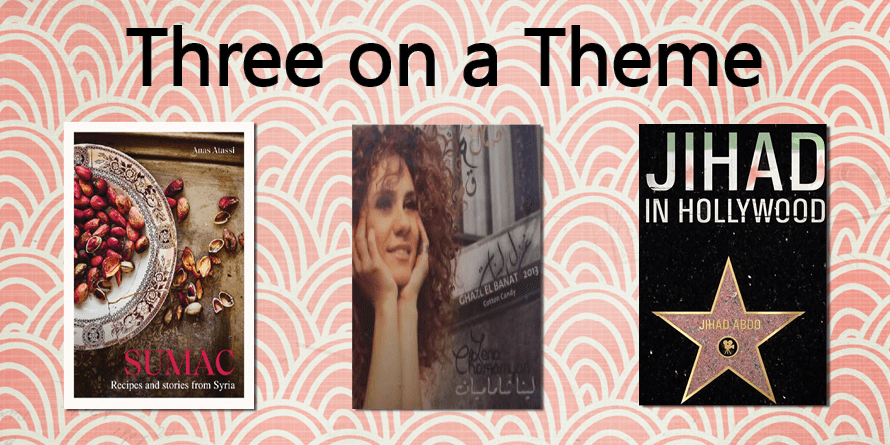
Submitted by Library staff member Libby L.
In this post, we are celebrating Syrian culture, particularly the diaspora communities here in America, and worldwide. You, dear reader, are invited to listen to some music, cook up a recipe, and watch a film. I invite you to join me in all or any of these activities – you might do one of these things, or you might do all of them. You might make an evening out of it, or you might sprinkle these activities throughout your week. You could spend an hour in the kitchen learning a new recipe, or five minutes on your lunch break listening to one song.
All materials are available through our catalog, or through the free streaming platforms Kanopy (movies/television) or Freegal (music.)
Through cooking, we have an opportunity to connect to people of different backgrounds and different foodways. When reading a cookbook from a diaspora community, as with Sumac by Anas Atassi, we as readers can learn a bit about what connects a person to the place they’re from. Multiculturalism is a global phenomenon, but it’s also distinctly American, and so I’ve chosen a cookbook today by an author who is currently based in Amsterdam because his story is like many Syrians living in the diaspora today in America.
In Sumac, you’ll learn to use essential flavors and spices from Atassi’s culture – Aleppo pepper, za’atar, and sumac. Some of these ingredients may already be familiar to you – there is a lot of cross-cultural usage of some ingredients, including pomegranate molasses and tahini. So how do we know what is distinctly Syrian, Iraqi, Turkish, etc.? Anas Atassi says that even within Syria, the cuisine is highly dependent on which region of the country you’re in. How the ingredients come together, in what quantities, is as important as which ones you’re using.
Anas Atassi’s book represents a Syria that is not overshadowed by war or conflict.
Album: The Collection by Lena Chamamyan
Music, much the same as cooking, offers us a way to connect to the universal human qualities that we all share, through the lens of a person’s unique expression of their experiences. Lena Chamamyan is a Syrian-Armenian singer-songwriter. She brings together Syrian classical and contemporary music genres, through her folkloric style with modern arrangements. Lena Chamamyan was born in Damascus, Syria, in 1980. She resettled in Paris in 2011, after the Syrian Civil War began. (More than 14 million Syrians were forced to flee their home as a result of this conflict.) As an Armenian-Syrian living in Paris, she lives in both the Syria diaspora and Armenia diaspora communities. Her voice is pure and profound, “carrying a nostalgia for the sweetness of Damascan life.”
“Today, when they ask me about my identity, I answer ‘Songs, words, and dreams’.” – Lena Chamamyan
If you look up Jay Abdo, you may see a common tagline from articles about this Syrian actor – “The movie star who fled Syria to deliver pizza in Hollywood.”
In the short documentary Jihad in Hollywood (Jay’s first name used to be Jihad) you can catch a glimpse of Jay’s life after fleeing the Syrian Civil War. Despite being a famous actor in Syria, he struggled to get work in Hollywood initially. In the short film, follow Jay and his wife’s day-to-day life as he re-establishes his acting career.
Thank you for joining me on this brief journey through Syrian culture and the senses. As parting food-for-thought, consider this quote about a different documentary of Syrian refugee artists, The Story Won’t Die:
This post was inspired in part by Justice in June’s project to tackle anti-racism daily, for 10, 25, or 45 minutes per day.
“Justice in June cultivates a community rooted in truth, inspires action and is committed to awareness.” - Autumn Gupta, with Bryanna Wallace


